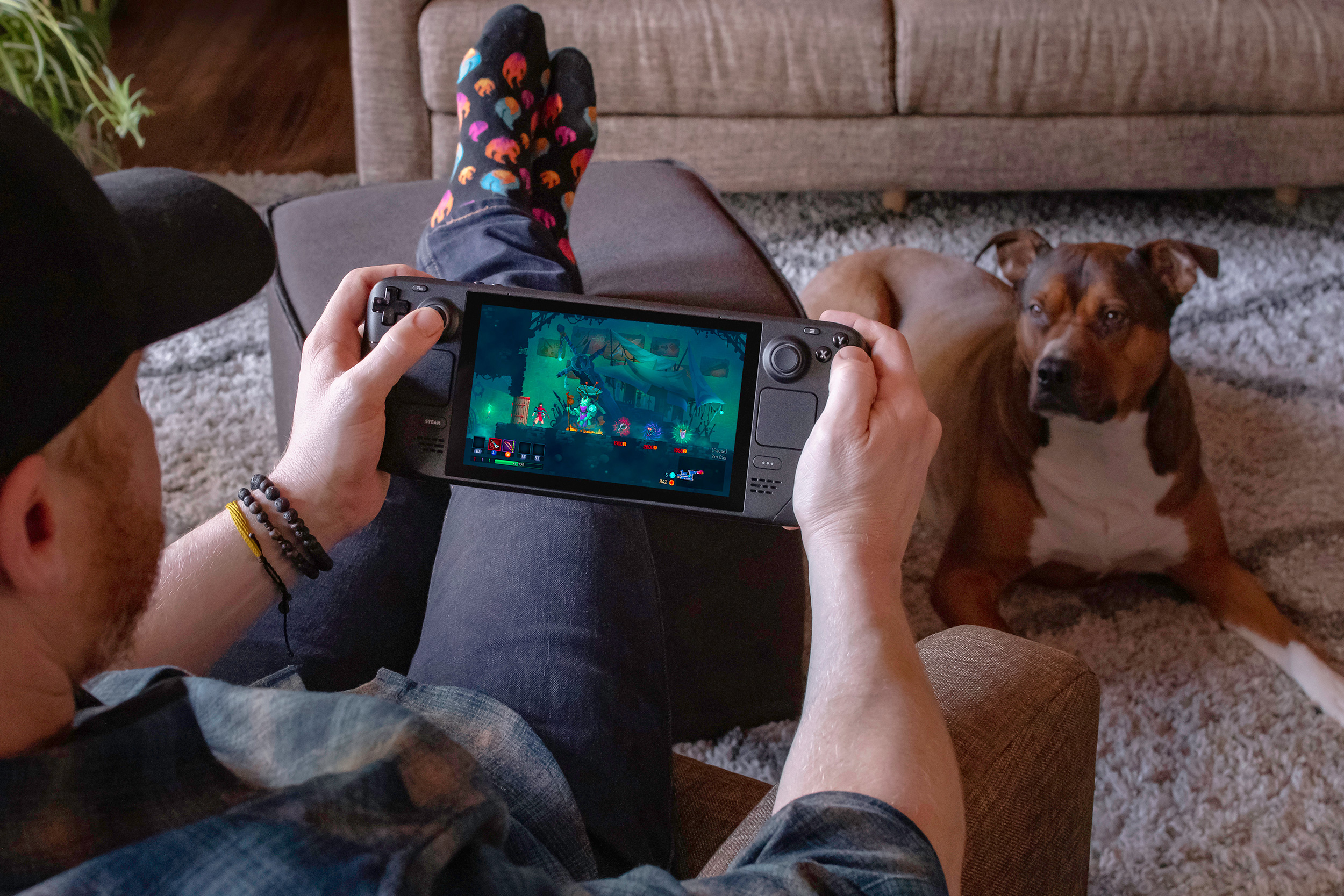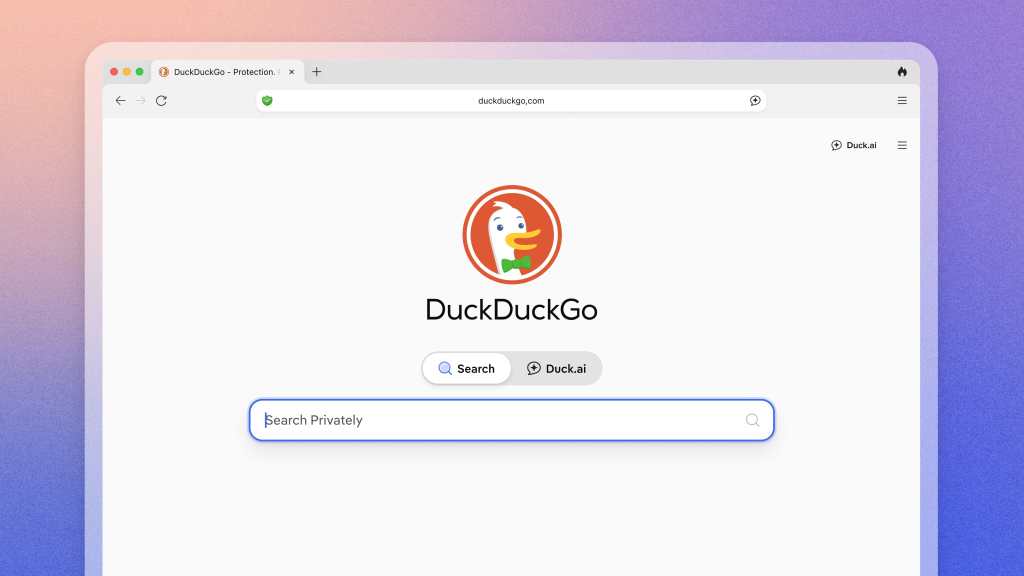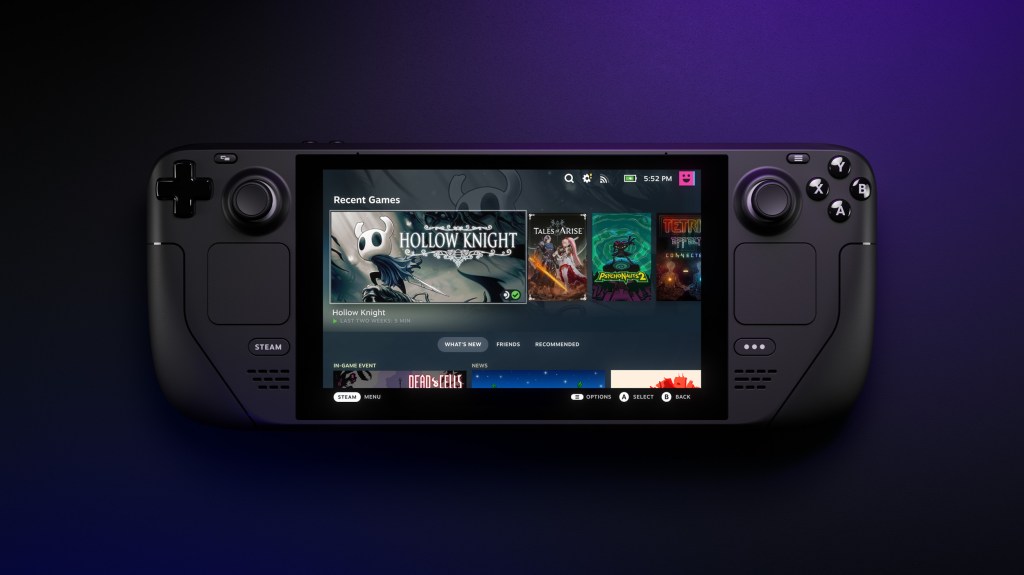On Tuesday, my daughter was in dance class. COVID restrictions meant I couldn’t watch, so I found myself with an hour to kill, while the sound of 7-year-olds poorly shooting basketballs squeaked around me. Luckily, I had a Steam Deck, Valve’s new portable handheld that’s basically a mini computer, inside my backpack. I wanted to try a demo of Neon White, the horny shooter-slash-visual novel from the designer of Donut County, and so I hopped on park district Wi-Fi, gobbled 2GB (hoping the IT person wouldn’t notice), and spent an hour playing a game that’s most likely gonna be one of my favorites later this year.
Neon White isn’t designed for Steam Deck, a device that runs on Valve’s proprietary version of Linux, SteamOS. It’s meant to run on Windows. But Steam Deck uses a propri—look, it doesn’t matter? The technical underpinnings of how Steam Deck works are interesting, but the reality is that it’s invisible to you. Pick a game you want to play on Steam, and chances are, it’ll run on your Steam Deck. Steam Deck takes a guess at the control scheme, and most of the time it works. If it doesn’t, you can customize to your liking. At times, it’s clunky and requires a level of tweaking that feels odd on a handheld, but mostly, it feels like magic.
Videos by VICE
That magic comes with caveats: the (hot) fan runs loudly and constantly, even when idling; the battery life is all over the place and rarely lasts more than a few hours on games that are modestly taxing to the hardware; it’s large and awkward to hold. But time and time again, it accomplished a simple but complicated task: play games wherever I want, whenever I want. It suggests a world that broadens the definition of a “PC gamer,” making it less about how much you overspent on a GPU and more about PC gaming’s other biggest benefit: freedom.
Can you load the Steam Deck up with emulators? Yep. Can you run games the Steam Deck isn’t powerful enough for, just to see how it works, even though it’s probably going to be a bad experience with a terrible frame rate? Sure. Can you drop straight into a full desktop mode that looks an awful lot like Windows but doesn’t work exactly like Windows but will let you load non-gaming software, like Chrome and Spotify? Absolutely. Can you start tinkering with Linux command lines and mess up the device? Genuinely, nothing’s stopping you.
(The last one is hard to do. You’d have to seek it out. Nobody will do it by accident. But!)
Previously, the closest solution to something like the Steam Deck was a clunky, expensive gaming laptop. It’s shocking what they can stuff inside a laptop these days, but often, their sheer size stretches the definition of “portable.” It’s a smaller computer. This is a handheld.
Steam Deck is the anti-Switch, the opposite of Nintendo’s locked down fortress. I say that as someone who deeply loves Nintendo games, but in the same month that Nintendo announced it’s shutting down the eShop on the Wii U and 3DS without a path forward for thousands of games to be playable on other devices, I look at the Steam Deck, a machine that could probably run those games if I jumped through hoops, and smiled. Even in a world where Steam shuts down tomorrow, the device still works. You could just install Windows.
“It suggests a world that broadens the definition of a “PC gamer,” making it less about how much you overspent on a GPU and more about PC gaming’s other biggest benefit: freedom.”
Of course, even Nintendo’s devices are, eventually, easily hackable to do whatever you want, even to play games Nintendo would prefer you buy for the 10th time. But that’s an exploit. With Steam Deck, it’s not a bug—it’s a feature. There’s a streamlined experience for people who just wanna buy games and play ‘em, but for everyone else, what’s in your hands is a powerful computer that can fit in a backpack—a large one, anyway—where its creators have given you permission to look under the hood and do what you will. If the philosophy governing Microsoft, Nintendo, and Sony is a gated and curated playground, Steam Deck adopts the same appearance, before opening a side hatch that asks “hey, wanna get weird?”
I say all this knowing the device I’ve used the most in the last five years is a Switch.
Seven months after my first child was born, Nintendo launched the Switch. It couldn’t have come at a more opportune moment, when it was suddenly harder to lock myself in a room to play games. Life was determined by the baby’s needs, but the portable Switch meant that if a few free minutes appeared, I could pull out my Switch and make progress. And for the past five years, that’s been a good relationship, as it’s continued to make games part of my day-to-day, even as my free time dwindled while my children increased—then one, now two.

But woof, the Switch was an already aging piece of technology when it arrived in 2017, a machine whose hardware was—and still is—best tapped and understood by its creators at Nintendo. Convenience won the day, though, and for a while, the Switch was the way to experience my bread and butter, smaller independent games. Those, thankfully, ran great.
Until recently. Now, those games—even the ones that seem technically simple—are sweating on Switch, and on the high-end, companies are increasingly turning towards cloud streaming as a solution. There are even red flags with Nintendo, with a game like Bowser’s Fury dropping between 60 FPS and 30 FPS, depending on whether you’re playing in docked or handheld mode. Cloud stream tech is generally better than you might think, but it’s a bandwidth hog and playing locally, on a piece of hardware in your house or in your hands, is always a superior experience. I’ve tried streaming from my PC (and consoles) to an iPhone using a device like Backbone, but the wireless remains too spotty to make it feel smooth.
Everything is a compromise, but increasingly, I’ve looked at my Switch and its beautiful and functional form factor and wondered why that little screen couldn’t display something else.
The solution, then, has been to head to my office, and spend more time in the space I’m already in for work. That’s where my PC is, and that’s where the majority of my consoles are. The Switch lives upstairs. My office, a place I’ve left even less frequently than usual during the nearly two years we’ve been living with COVID. I don’t want to be in that room more than I have to be, leading to my desperate hunt to find ways to shift my gaming time into a more relaxing context, or more likely, dealing with a progressively subpar experience on a Switch.

“The last couple of years [of] working from home, I ended up really valuing being able to play the same PC games that I want to experience just away from my normal desk where I’m also doing all my day to day work,” said Steam Deck engineer Pierre-Loup Griffais, who’s been working on a version of the device for several years, in an interview with Waypoint recently.
“My journey has been slightly cursed by becoming a game developer,” added Valve designer Jake Rodkin (Firewatch, The Walking Dead) in the same interview. “I grew up playing both console and PC a lot, both ended up being a big part of my childhood. But again, partly because I look at a computer [screen] all day, I started fading away from playing games as much. Definitely the workstation and fun being inside of the same box was a thing that I grew apart for me. […] This last year or so has further enforced that, where sitting in my desk and staring deep into a Zoom window has, again, recontextualized my relationship with my PC.”
Big same.
The Steam Deck is, at first blush, comically large. My five-year-old scoffed when I took it out of the box for the first time, before noting that it felt surprisingly light. (She’s right.) People have been rightfully skeptical of the dense controller scheme Valve has stuffed onto this thing, which sports two analog sticks, a d-pad, four face buttons, two touchpads, start/select equivalents, four top bumpers, four back buttons. Oh, and there’s a gyro sensor in there, too.

I’ve spent a dozen or so hours with my Steam Deck, and I still can’t tell you how I feel about holding the thing. I’m less convinced of it than I am resigned to its form. At times, at the right angle, it falls neatly into place and I’m zipping along as easily as I would on any other device. Other times, I find my hands comfortably resting in a way that makes holding the handheld seem great, but prevents me from easily accessing all of the top bumpers at a moment’s notice. I’ve hit the back buttons by accident frequently enough that I always turn them off.
I don’t think Valve has pulled an ergonomics miracle, but I did get used to it? Rolling around and swinging swords in Dark Souls felt good. Shooting werewolves in the face in Resident Evil Village—a truly impressive game on Steam Deck, running at 60 FPS—was fine.
A small but important note: the Steam Deck can survive an unfortunate and unexpected fall out of your hands and onto the parking lot of your child’s gym—a parking lot full of sludge and snow, mind you. “Dad, you really should check to see if the case is closed,” my oldest told me as I not-so-quietly screamed “fuck!’ into the cold air and scrambled to pick it up.
I’ve been dealing with the psychic damage of that comment ever since.
Anyway, there are times where having the device stuffed to gills proved incredibly useful, too.
Take S.T.A.L.K.E.R.: Shadow of Chernobyl, for instance. The seminal 2007 open world shooter is a PC-ass-PC game. There is no gamepad support in S.T.A.L.K.E.R.—this is a game meant to be played with a keyboard and mouse. And yet, S.T.A.L.K.E.R. is totally playable on a Steam Deck for a couple of different reasons, some of which are the culmination of other experiments Valve’s been running in the years leading to Steam Deck.
When you load S.T.A.L.K.E.R., the Steam Deck pairs the game with the most popular community control scheme. Steam Deck arrives years after Valve discontinued its quirky Steam Controller, but Steam Controller’s legacy includes having encouraged communities to develop and custom controller schemes for alternative inputs. Here, it’s “PizzaWizard’s STALKER controls,” which has 881 likes and 3,889 hours of use. PizzaWizard has neatly mapped much of the game’s intricate interface to different parts of the Steam Deck, letting me immediately start playing portable S.T.A.L.K.E.R.. Even better, the parts that didn’t work on the Steam Deck were easy to fix, as modifying PizzaWizard’s work took only a moment.
Nothing like this exists outside of the Steam ecosystem, Switch or otherwise.
Is it the ideal way to player S.T.A.L.K.E.R.? Nah. You’d still want a computer for that. But is it a cool way to play S.T.A.L.K.E.R., especially if it’s your second time jumping in? Hell yeah.
It’s at this point that you, like me, will open their Steam library and go “I wonder how [X] plays?” Which is how I ended up replaying the opening hour of Inscryption. It played great.
In other instances, you’ll be left scratching your head. Elden Ring runs (okay) on a Steam Deck, but the game won’t let you play online—it told me my actions were “inappropriate activity.” (Update: This changed between me writing this and Elden Ring launching. Now, it’ll play fine, online and all.) Destiny 2 wouldn’t run, either. Same with Lost Ark. In the case of Lost Ark, Valve engineer Pierre-Loup Griffais told me it should run, but it’s on game companies to tweak a few things to allow it through. Whether that happens, though, I have no idea. You can get around this by streaming from your PC to a Steam Deck, but again, it’s always ideal to be playing locally, and for as much freedom as Steam Deck allows, there are instances in which you’ll be left at the mercy of the people who make games caring. That’s an open question, and companies like Epic Games have already explicitly said no to supporting Steam Deck.
There are other instances where the Switch comparisons fall apart, too.
The Switch truly is a hybrid device, and with most models, comes with a handy dock and detachable controllers to make the transition seamless. The Steam Deck really isn’t. It’s a singular device that does not come apart, though it does support Bluetooth controllers. An official dock is coming, but Valve recently delayed it to “late spring.” You can connect the Steam Dock to a TV using a USB-C-to-HDMI cable, but the device won’t charge while you’re playing, and with the Steam Deck, you are always thinking about how fast the battery is draining. You will not get extremely long sessions out of it without attached a charging brick, or buying a USB hub that could output the device through HDMI and charge simultaneously.

Once, I connected my Steam Deck to a TV while playing Village—again, one of the games that performs best on the device—and it looked pretty crummy on my big TV. The fan kicked into high gear, the lower resolution stuck out, and suddenly that frame rate wasn’t as slick.
It’s a powerful handheld, but exactly that: a handheld, perhaps suited for your nightstand. There’s nothing wrong with that, either. I rarely use my Switch in docked mode, anyway.
What I wanted and hoped from Steam Deck was a more versatile and powerful Switch, and it’s proven to be capable of filling that niche—and more. While the limited battery and rowdy fan are noticeable—and feel like the kind of thing that’ll be much better in a Steam Deck 2.0, if Valve doesn’t drop interest in the device like many of its other side adventures—it’s not a deal breaker.
The Steam Deck can feel like magic, but in reality, it’s a very cool computer. Nothing wrong with that.
Follow Patrick on Twitter. His email is patrick.klepek@vice.com, and available privately on Signal (224-707-1561).
More
From VICE
-

Photo: dbvirago / Getty Images -

Credit: DuckDuckGo -

Photo: Oleg Breslavtsev / Getty Images -

Photo: HEX / Getty Images
